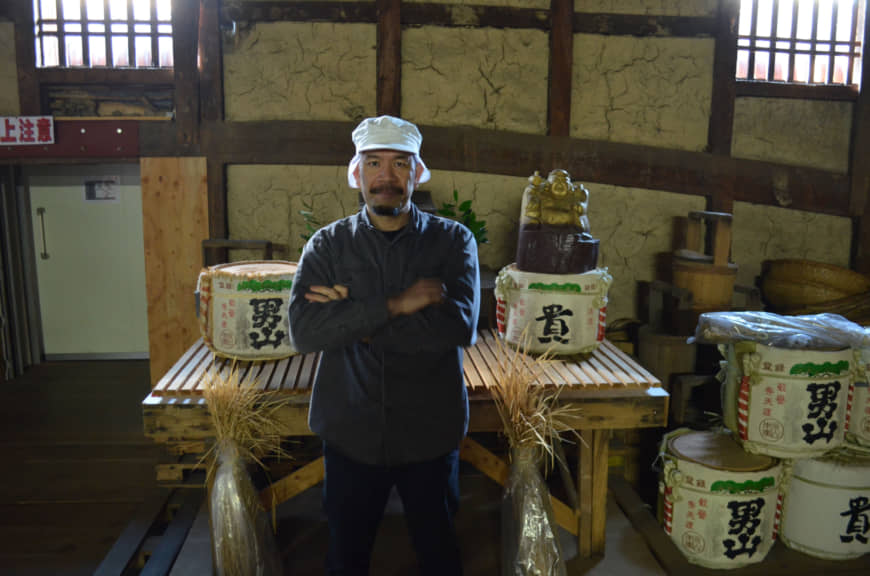ジャパンタイムス : The Japan Times / Mar 7, 2020

Nagayamahonke Shuzojo:
Sake with terroir takes
root in Yamaguchi
The surreal landscape of the Akiyoshidai Plateau, located in Mine, Yamaguchi Prefecture, a 30-minute drive from Shin-Yamaguchi Station, is a vast swath of grassland dotted with jagged white stones that sprout from the ground like stegosaurus spines.
It sits above Japan’s largest limestone cave, where groundwater flows over the terraced rock layers and absorbs minerals from the limestone, which formed from a coral reef roughly 250 million years ago. The high levels of calcium in the water, explains fifth-generation sake maker Takahiro Nagayama, lend distinctive notes of minerality to the sake he produces at Nagayamahonke Shuzojo.
Until relatively recently, the question of regional identity in sake has been largely unexplored. However, Nagayama aimed to create brews that would express the uniqueness of the terrain when he launched his signature brand, Taka, nearly 20 years ago. For the 44-year-old brewer, that meant focusing on the raw ingredients of water and local rice, rather than brewing techniques.
“For me, it all started with the water. I wanted the sake to be clean, with citrus-like acidity and firm minerality,” he says.
The calcium-rich water he uses for brewing is also used to grow Yamada Nishiki rice on three hectares of land in front of the brewery.
While most brewers purchase sake rice from agricultural co-ops that source grains from all over the country, Nagayama is part of a growing movement of producers who take cues from the wine world by using local rice, and even growing their own.
After two years as an exchange student in Vancouver, he studied at the National Research Institute of Brewing in Hiroshima before taking over the family business in 2001. While researching the effects of different rice strains on sake and grape varietals on wine, he became interested in the concept of terroir — the influence of the natural environment on the flavor of the final product.
Seeking a deeper understanding of the wine industry, Nagayama traveled to Europe in 2007. In France, he fell in love with natural wine and visited iconic producers, such as Philippe Pacalet and Clos de Vougeot, in the Burgundy region. Impressed by the philosophy behind organic and biodynamic agriculture, he wanted to implement similar practices in the sake world.
“There’s a tendency among sake makers to focus on what goes on inside the brewery — machinery and technique — but if you talk solely about that, (even artisan) sake begins to feel like a factory-made product,” Nagayama says. “In the wine world, they talk more about the environment and sustainability.”
He sought out like-minded brewers to exchange ideas on how to grow rice without fertilizer and pesticides. Japan’s hot, humid summers poses substantial challenges to organic farmers. Although Nagayama admits he still uses small amounts of agrichemicals, he recently bought a high-tech weeding machine that will allow him to further curb their use.
“For the sake industry, the move toward sustainability will require a lot of investment, but there’s no other way,” he continues. Nagayama has also purchased a planter and tractor equipped with sensors that allow him to closely monitor weather conditions and soil moisture.
On a recent visit to Nagayamahonke Shuzojo, I sample a lineup of eight diverse brews over a dinner catered by local French restaurant N-3trois. I’m struck by the thread of steely tension that ran through each drink. A limestone minerality was equally present in Nagayama’s 2015 Taka Yamahai Junmai Daiginjo, a supple brew with butterscotch and rice notes, and the just-pressed Taka Tokubetsu Junmai Jikagumi 60 Shinshu, a vivid number with hints of bright citrus.
“More and more brewers in Japan are automating to make mass-produced daiginjō (the highest grade of sake), but I put my heart into making sake that conveys my philosophy — a drink that expresses this environment,” he says, gesturing to the window. “It’s part of the experience of sharing time and food together.”
永山本家酒造場と
テロワール。
山口県に根差した酒造り。
新山口駅から車で30分、山口県美祢市の広大な秋吉台と呼ばれる台地にはステゴザウルスの背骨が台地から突き出したような岩がゴロゴロと転がっています。その台地の下には秋吉台の石灰石を含んだ雨水が2億5000万年の年月を掛け、幾重にも岩が重なったような不思議な形を形成した日本最大の鍾乳洞 秋芳洞があります。この秋吉台の石灰石を含んだ水が、他と明確に差別化された日本酒を作るのだと永山本家酒造場の5代目、永山貴博さんは言います。
実は最近まで日本酒はどこで作られたのかを余り問題にされませんでした。そんな中、永山さんはで20年前に自身のブランド 貴を立ち上げる頃からこのユニークな地域性に着目していました。今年44歳になる永山さんが20年の杜氏の歴史の中でいつもフォーカスしてきた事は、醸造法でなく酒を造る水と米でした。
「私はこの水に出会った時、心地よい酸味を持ったクリアで辛口のお酒をできると確信しました。」永山さんの地元を思う気持ちは、ほとんどの蔵が米を農業組合から入手するのに対し、山田錦の自家栽培へと及んでいきます。永山さん考えや行動を後押ししたのは、杜氏になる過程で出会ったワインの世界でした。
2001年蔵を継ぐことを決意した永山さんは広島の醸造研究所で酒作りとぶどうを学びました。そこで何種類ものぶどうからワインが作られていることや土が最終的にどのようにワインに影響を与えるかなどを知り次第にワインに興味を持つとともにその土地らしさという意味の「テレロワール」のコンセプトに魅かれていきました。
2007年から、更なるワインの世界を求めフィリップ・パカレなどの自然派やアイコン的なワイナリーを訪れ、ワインのオーガニック的な考えを酒造りに応用したいと考えました。
「日本酒の世界には醸造法に力を注ぎ、さらにそのメソッドを機械的なプログラムにしようとする傾向があります。しかしそれでは日本酒がどんどん工業製品のようなものになってしまいます。一方ワインにはいつも環境とサステナブルという考えと一緒にあります。」
永山さんは(夏湿度が高い日本という理由で多くの人が躊躇する中)最終的には化学肥料と農薬を使わない稲作を実現したいと言います。そして今年本格的に農業法人を立ち上げ、土の湿度をコントロールするなどのハイテク技術の導入や田植えトラクターの購入などに踏みきりました。
わたし(著者)が蔵を訪れた時に8種類の利き酒と一緒に地元のN-3troisというフレンチレストランが用意してくださったお料理をいただきました。私は全てのお酒に共通したとても緊張感のある味わいとその繊細さに打たれました。2015年の貴山廃純米大吟醸はライムストーン(石灰)によるミネラルに支えられた中にバターとお米の風味の芳醇さを感じる深い味わいです。また搾りたての貴特別純米直汲60新酒は鮮やかな何種類もの酸味を感じることができました。
「今、どんどん日本の酒造りは純米大吟醸の大量生産と機械化の道を進んでいます。しかし私は自身が思う酒造りの哲学を実現したいと思います。それは、この素晴らしい自然が表現するお酒です。」と永山さんは、蔵のを外に広がる水田を差して言います。「どうぞこの時間と素晴らしい食事を共有しませんか。」




